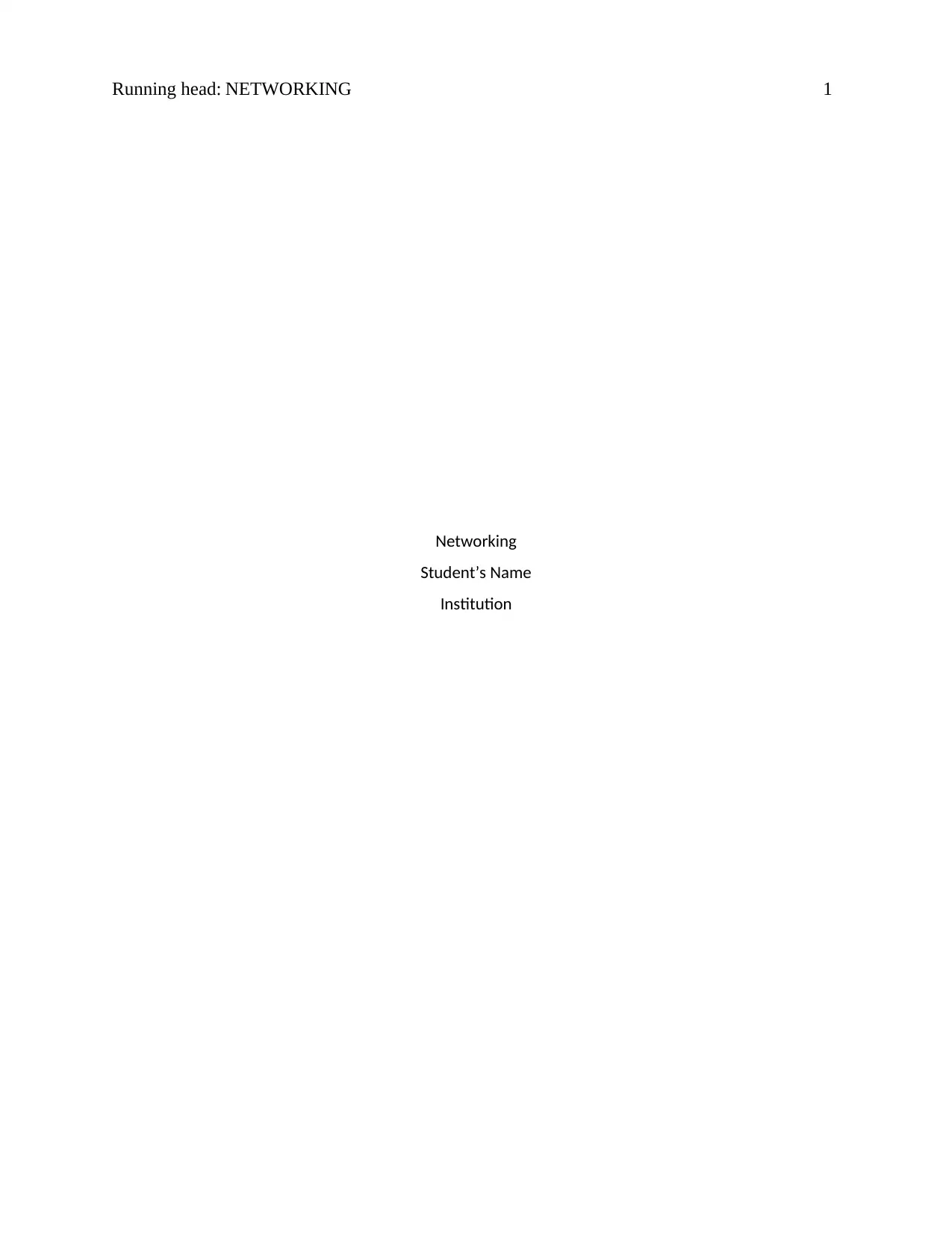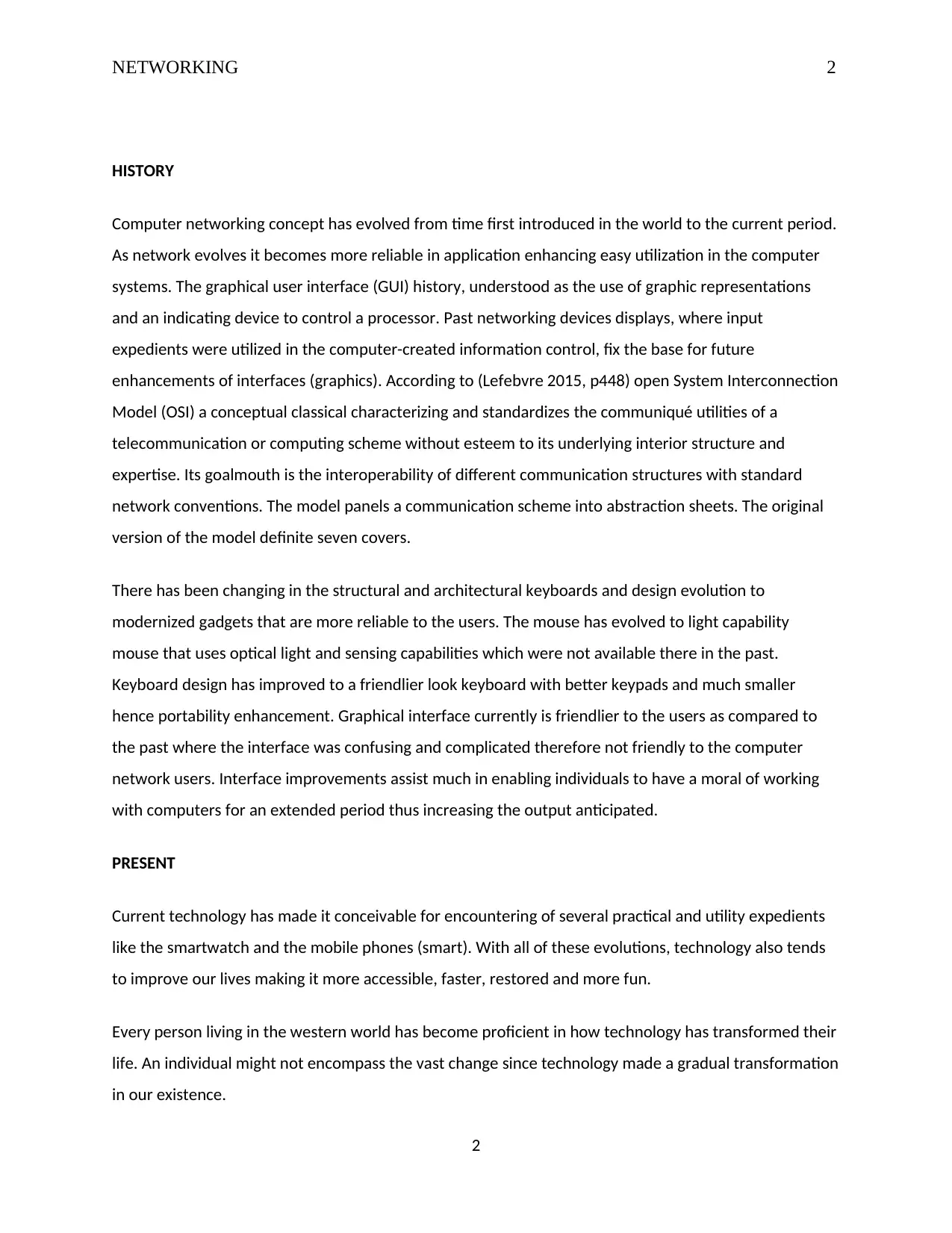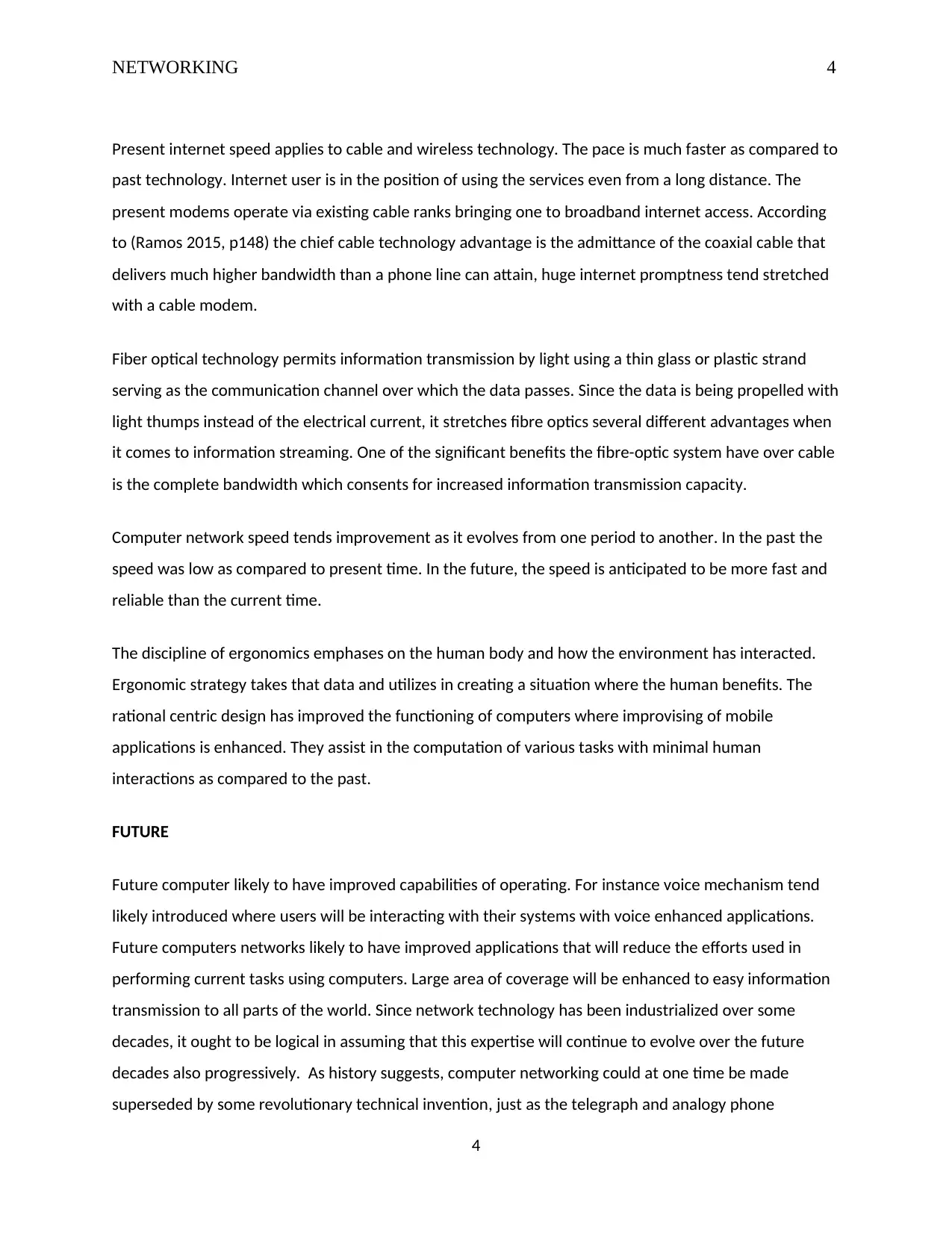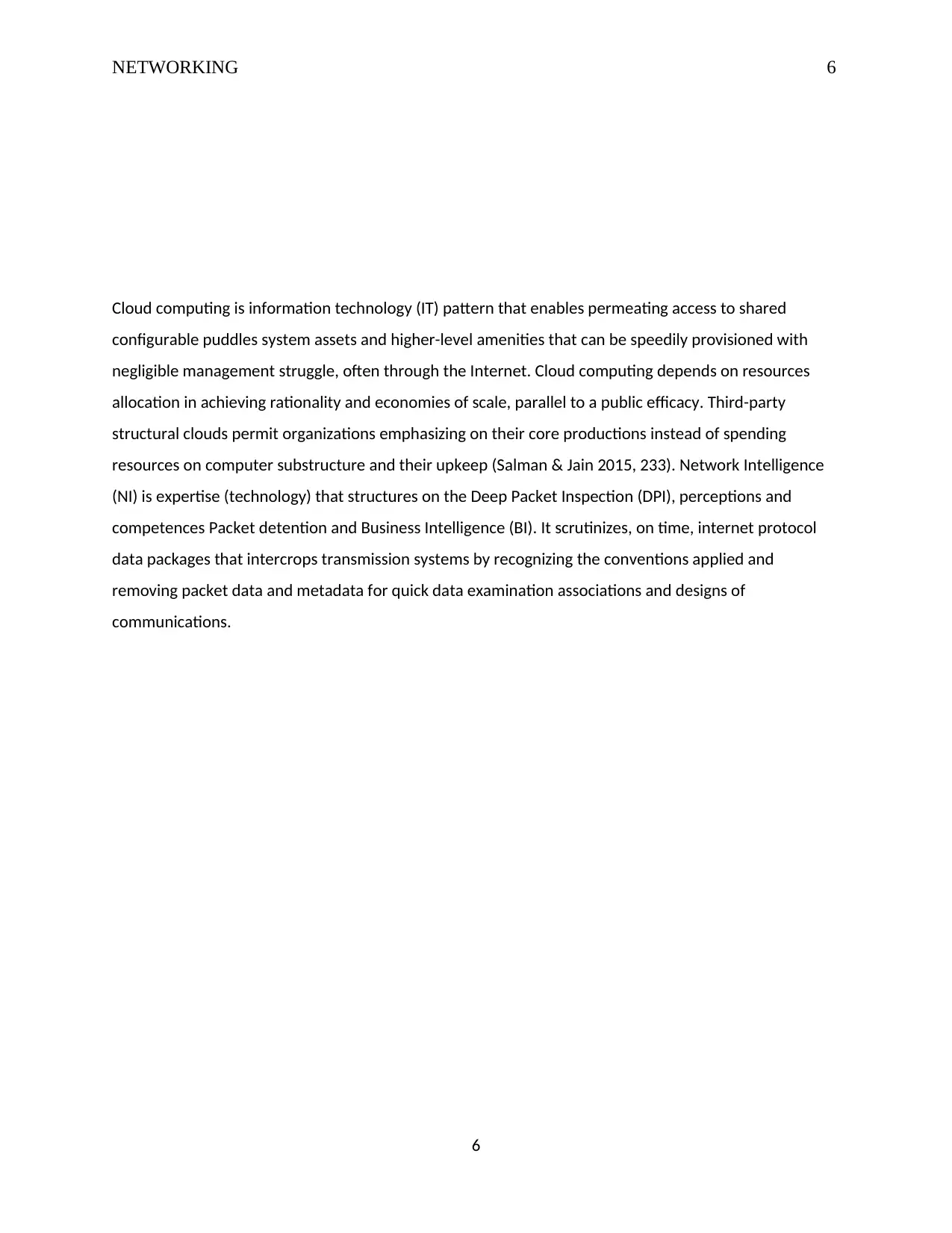MN503 Internetworking: Network Analysis, Plan, and Future Trends
VerifiedAdded on 2023/06/07
|7
|1600
|253
Report
AI Summary
This report provides a comprehensive overview of computer networking, tracing its evolution from early graphical user interfaces and the OSI model to current technologies like smartwatches, mobile phones, and advanced routing protocols. It contrasts past networking limitations, such as slow DSL speeds, with present-day cable and wireless technologies, highlighting the advantages of fiber optics. The report also explores future trends, including Software Defined Networking (SDN) and cloud computing, emphasizing their potential to enhance network flexibility, efficiency, and accessibility. It touches on network intelligence and deep packet inspection, illustrating the ongoing advancements in network capabilities and management. This document is available on Desklib, a platform that provides students with access to a wealth of study tools and solved assignments.

Running head: NETWORKING 1
Networking
Student’s Name
Institution
Networking
Student’s Name
Institution
Paraphrase This Document
Need a fresh take? Get an instant paraphrase of this document with our AI Paraphraser

NETWORKING 2
HISTORY
Computer networking concept has evolved from time first introduced in the world to the current period.
As network evolves it becomes more reliable in application enhancing easy utilization in the computer
systems. The graphical user interface (GUI) history, understood as the use of graphic representations
and an indicating device to control a processor. Past networking devices displays, where input
expedients were utilized in the computer-created information control, fix the base for future
enhancements of interfaces (graphics). According to (Lefebvre 2015, p448) open System Interconnection
Model (OSI) a conceptual classical characterizing and standardizes the communiqué utilities of a
telecommunication or computing scheme without esteem to its underlying interior structure and
expertise. Its goalmouth is the interoperability of different communication structures with standard
network conventions. The model panels a communication scheme into abstraction sheets. The original
version of the model definite seven covers.
There has been changing in the structural and architectural keyboards and design evolution to
modernized gadgets that are more reliable to the users. The mouse has evolved to light capability
mouse that uses optical light and sensing capabilities which were not available there in the past.
Keyboard design has improved to a friendlier look keyboard with better keypads and much smaller
hence portability enhancement. Graphical interface currently is friendlier to the users as compared to
the past where the interface was confusing and complicated therefore not friendly to the computer
network users. Interface improvements assist much in enabling individuals to have a moral of working
with computers for an extended period thus increasing the output anticipated.
PRESENT
Current technology has made it conceivable for encountering of several practical and utility expedients
like the smartwatch and the mobile phones (smart). With all of these evolutions, technology also tends
to improve our lives making it more accessible, faster, restored and more fun.
Every person living in the western world has become proficient in how technology has transformed their
life. An individual might not encompass the vast change since technology made a gradual transformation
in our existence.
2
HISTORY
Computer networking concept has evolved from time first introduced in the world to the current period.
As network evolves it becomes more reliable in application enhancing easy utilization in the computer
systems. The graphical user interface (GUI) history, understood as the use of graphic representations
and an indicating device to control a processor. Past networking devices displays, where input
expedients were utilized in the computer-created information control, fix the base for future
enhancements of interfaces (graphics). According to (Lefebvre 2015, p448) open System Interconnection
Model (OSI) a conceptual classical characterizing and standardizes the communiqué utilities of a
telecommunication or computing scheme without esteem to its underlying interior structure and
expertise. Its goalmouth is the interoperability of different communication structures with standard
network conventions. The model panels a communication scheme into abstraction sheets. The original
version of the model definite seven covers.
There has been changing in the structural and architectural keyboards and design evolution to
modernized gadgets that are more reliable to the users. The mouse has evolved to light capability
mouse that uses optical light and sensing capabilities which were not available there in the past.
Keyboard design has improved to a friendlier look keyboard with better keypads and much smaller
hence portability enhancement. Graphical interface currently is friendlier to the users as compared to
the past where the interface was confusing and complicated therefore not friendly to the computer
network users. Interface improvements assist much in enabling individuals to have a moral of working
with computers for an extended period thus increasing the output anticipated.
PRESENT
Current technology has made it conceivable for encountering of several practical and utility expedients
like the smartwatch and the mobile phones (smart). With all of these evolutions, technology also tends
to improve our lives making it more accessible, faster, restored and more fun.
Every person living in the western world has become proficient in how technology has transformed their
life. An individual might not encompass the vast change since technology made a gradual transformation
in our existence.
2

NETWORKING 3
Over the years, it has transfigured our viewpoint of the world and creating amazing tools and
possessions, putting each’s most useful info at their fingertips.
Routing is one of significant internet protocol where it is a process of choosing a traffic path in a
network, or between or crossways multiple systems. Generally, routing is achieved in many kinds of
networks such as computer networks. Dynamic routing is advantageous in the sense that can grow more
rapidly and more prominent and is capable of adapting to variations in the system topology (Salman &
Jain 2015, p219). The disadvantage is that it requires further components like CPU and memory.
Diagram of dynamic routing protocol
The past speed of network technology was slow in application due to lack of technological
improvement. Digital Subscriber Line (DSL) was utilized where it applied a complicated modulation
project to fit data into copper cables. Location of the DSL modem depended on the provider, but it
cannot be situated too far from the operator as a reason for weakening and loss of data.
3
Build and construct WSN nodes
Uniform nodes application
Combine cockroach network with
DSR
Carry out data packet revolution
Finding best period path among
existing nodes
Forecast high and low power
nodes
Consumption of power
Over the years, it has transfigured our viewpoint of the world and creating amazing tools and
possessions, putting each’s most useful info at their fingertips.
Routing is one of significant internet protocol where it is a process of choosing a traffic path in a
network, or between or crossways multiple systems. Generally, routing is achieved in many kinds of
networks such as computer networks. Dynamic routing is advantageous in the sense that can grow more
rapidly and more prominent and is capable of adapting to variations in the system topology (Salman &
Jain 2015, p219). The disadvantage is that it requires further components like CPU and memory.
Diagram of dynamic routing protocol
The past speed of network technology was slow in application due to lack of technological
improvement. Digital Subscriber Line (DSL) was utilized where it applied a complicated modulation
project to fit data into copper cables. Location of the DSL modem depended on the provider, but it
cannot be situated too far from the operator as a reason for weakening and loss of data.
3
Build and construct WSN nodes
Uniform nodes application
Combine cockroach network with
DSR
Carry out data packet revolution
Finding best period path among
existing nodes
Forecast high and low power
nodes
Consumption of power
⊘ This is a preview!⊘
Do you want full access?
Subscribe today to unlock all pages.

Trusted by 1+ million students worldwide

NETWORKING 4
Present internet speed applies to cable and wireless technology. The pace is much faster as compared to
past technology. Internet user is in the position of using the services even from a long distance. The
present modems operate via existing cable ranks bringing one to broadband internet access. According
to (Ramos 2015, p148) the chief cable technology advantage is the admittance of the coaxial cable that
delivers much higher bandwidth than a phone line can attain, huge internet promptness tend stretched
with a cable modem.
Fiber optical technology permits information transmission by light using a thin glass or plastic strand
serving as the communication channel over which the data passes. Since the data is being propelled with
light thumps instead of the electrical current, it stretches fibre optics several different advantages when
it comes to information streaming. One of the significant benefits the fibre-optic system have over cable
is the complete bandwidth which consents for increased information transmission capacity.
Computer network speed tends improvement as it evolves from one period to another. In the past the
speed was low as compared to present time. In the future, the speed is anticipated to be more fast and
reliable than the current time.
The discipline of ergonomics emphases on the human body and how the environment has interacted.
Ergonomic strategy takes that data and utilizes in creating a situation where the human benefits. The
rational centric design has improved the functioning of computers where improvising of mobile
applications is enhanced. They assist in the computation of various tasks with minimal human
interactions as compared to the past.
FUTURE
Future computer likely to have improved capabilities of operating. For instance voice mechanism tend
likely introduced where users will be interacting with their systems with voice enhanced applications.
Future computers networks likely to have improved applications that will reduce the efforts used in
performing current tasks using computers. Large area of coverage will be enhanced to easy information
transmission to all parts of the world. Since network technology has been industrialized over some
decades, it ought to be logical in assuming that this expertise will continue to evolve over the future
decades also progressively. As history suggests, computer networking could at one time be made
superseded by some revolutionary technical invention, just as the telegraph and analogy phone
4
Present internet speed applies to cable and wireless technology. The pace is much faster as compared to
past technology. Internet user is in the position of using the services even from a long distance. The
present modems operate via existing cable ranks bringing one to broadband internet access. According
to (Ramos 2015, p148) the chief cable technology advantage is the admittance of the coaxial cable that
delivers much higher bandwidth than a phone line can attain, huge internet promptness tend stretched
with a cable modem.
Fiber optical technology permits information transmission by light using a thin glass or plastic strand
serving as the communication channel over which the data passes. Since the data is being propelled with
light thumps instead of the electrical current, it stretches fibre optics several different advantages when
it comes to information streaming. One of the significant benefits the fibre-optic system have over cable
is the complete bandwidth which consents for increased information transmission capacity.
Computer network speed tends improvement as it evolves from one period to another. In the past the
speed was low as compared to present time. In the future, the speed is anticipated to be more fast and
reliable than the current time.
The discipline of ergonomics emphases on the human body and how the environment has interacted.
Ergonomic strategy takes that data and utilizes in creating a situation where the human benefits. The
rational centric design has improved the functioning of computers where improvising of mobile
applications is enhanced. They assist in the computation of various tasks with minimal human
interactions as compared to the past.
FUTURE
Future computer likely to have improved capabilities of operating. For instance voice mechanism tend
likely introduced where users will be interacting with their systems with voice enhanced applications.
Future computers networks likely to have improved applications that will reduce the efforts used in
performing current tasks using computers. Large area of coverage will be enhanced to easy information
transmission to all parts of the world. Since network technology has been industrialized over some
decades, it ought to be logical in assuming that this expertise will continue to evolve over the future
decades also progressively. As history suggests, computer networking could at one time be made
superseded by some revolutionary technical invention, just as the telegraph and analogy phone
4
Paraphrase This Document
Need a fresh take? Get an instant paraphrase of this document with our AI Paraphraser

NETWORKING 5
networks were displaced. Technology refers to networking as connecting a scheme of computers to
share info. The Internet is just that kind of service, and new philosophies and better structures are being
established every day. Thus the internet can be described as a 'cloud' or source for files and facilities
that we can access, but are installed in the computers directly. Technology is progressing on daily
services, demanding more from even our domestic systems.
In future networking Software Defined Networking (SDN) will be a vital aspect of consideration. Current
static architecture needs enhancement as days when we merely sat at a desk with a motionless
computer are surpassed (Kreutz et al. 2015). Now it has become possible and easy to travel with our
computing devices, and demand to be capable of utilizing applications at our fancy. To keep up with the
desired bandwidth and elasticity, SDN has become a general idea. Software Defined Networking, or SDN,
is a software (cloud-based) allowing management of the network from one principal point. The
significant is virtualization that styles it so software can run discretely from hardware devices. It would
be spontaneously responsive, and info technology workforces could view all glitches and difficult from
one position and have a much easier time dealing and curbing that particular problem.
Simple SDN operation diagram
5
SDN controller
Switching
device (data
plane)
Switching
device (data
plane)
Switching
device (data
plane)
Switching
device (data
plane)
Server
Cloud
networks were displaced. Technology refers to networking as connecting a scheme of computers to
share info. The Internet is just that kind of service, and new philosophies and better structures are being
established every day. Thus the internet can be described as a 'cloud' or source for files and facilities
that we can access, but are installed in the computers directly. Technology is progressing on daily
services, demanding more from even our domestic systems.
In future networking Software Defined Networking (SDN) will be a vital aspect of consideration. Current
static architecture needs enhancement as days when we merely sat at a desk with a motionless
computer are surpassed (Kreutz et al. 2015). Now it has become possible and easy to travel with our
computing devices, and demand to be capable of utilizing applications at our fancy. To keep up with the
desired bandwidth and elasticity, SDN has become a general idea. Software Defined Networking, or SDN,
is a software (cloud-based) allowing management of the network from one principal point. The
significant is virtualization that styles it so software can run discretely from hardware devices. It would
be spontaneously responsive, and info technology workforces could view all glitches and difficult from
one position and have a much easier time dealing and curbing that particular problem.
Simple SDN operation diagram
5
SDN controller
Switching
device (data
plane)
Switching
device (data
plane)
Switching
device (data
plane)
Switching
device (data
plane)
Server
Cloud

NETWORKING 6
Cloud computing is information technology (IT) pattern that enables permeating access to shared
configurable puddles system assets and higher-level amenities that can be speedily provisioned with
negligible management struggle, often through the Internet. Cloud computing depends on resources
allocation in achieving rationality and economies of scale, parallel to a public efficacy. Third-party
structural clouds permit organizations emphasizing on their core productions instead of spending
resources on computer substructure and their upkeep (Salman & Jain 2015, 233). Network Intelligence
(NI) is expertise (technology) that structures on the Deep Packet Inspection (DPI), perceptions and
competences Packet detention and Business Intelligence (BI). It scrutinizes, on time, internet protocol
data packages that intercrops transmission systems by recognizing the conventions applied and
removing packet data and metadata for quick data examination associations and designs of
communications.
6
Cloud computing is information technology (IT) pattern that enables permeating access to shared
configurable puddles system assets and higher-level amenities that can be speedily provisioned with
negligible management struggle, often through the Internet. Cloud computing depends on resources
allocation in achieving rationality and economies of scale, parallel to a public efficacy. Third-party
structural clouds permit organizations emphasizing on their core productions instead of spending
resources on computer substructure and their upkeep (Salman & Jain 2015, 233). Network Intelligence
(NI) is expertise (technology) that structures on the Deep Packet Inspection (DPI), perceptions and
competences Packet detention and Business Intelligence (BI). It scrutinizes, on time, internet protocol
data packages that intercrops transmission systems by recognizing the conventions applied and
removing packet data and metadata for quick data examination associations and designs of
communications.
6
⊘ This is a preview!⊘
Do you want full access?
Subscribe today to unlock all pages.

Trusted by 1+ million students worldwide

NETWORKING 7
References
Cappione III, A. J., Lefebvre, R., Kilcoin, N., King, D. A., & Dixon, G. J. (2015). U.S. Patent No. 8,959,448.
Washington, DC: U.S. Patent and Trademark Office.
Kreutz, D., Ramos, F. M., Verissimo, P. E., Rothenberg, C. E., Azodolmolky, S., & Uhlig, S. (2015).
Software-defined networking: A comprehensive survey. Proceedings of the IEEE, 103(1), 14-76.
Salman, T., & Jain, R. (2015). Networking protocols and standards for internet of things. Internet of
Things and Data Analytics Handbook (2015), 215-238.
7
References
Cappione III, A. J., Lefebvre, R., Kilcoin, N., King, D. A., & Dixon, G. J. (2015). U.S. Patent No. 8,959,448.
Washington, DC: U.S. Patent and Trademark Office.
Kreutz, D., Ramos, F. M., Verissimo, P. E., Rothenberg, C. E., Azodolmolky, S., & Uhlig, S. (2015).
Software-defined networking: A comprehensive survey. Proceedings of the IEEE, 103(1), 14-76.
Salman, T., & Jain, R. (2015). Networking protocols and standards for internet of things. Internet of
Things and Data Analytics Handbook (2015), 215-238.
7
1 out of 7
Related Documents
Your All-in-One AI-Powered Toolkit for Academic Success.
+13062052269
info@desklib.com
Available 24*7 on WhatsApp / Email
![[object Object]](/_next/static/media/star-bottom.7253800d.svg)
Unlock your academic potential
Copyright © 2020–2025 A2Z Services. All Rights Reserved. Developed and managed by ZUCOL.





![Operating System Architecture Report - [University Name], Semester 1](/_next/image/?url=https%3A%2F%2Fdesklib.com%2Fmedia%2Foperating-system-architecture-guide_page_2.jpg&w=256&q=75)